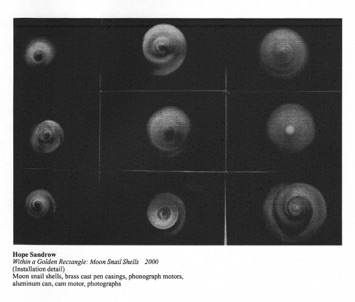The collection of shells revived childhood memories of Marcel Duchamp’s (1935) Rotoreliefs (Optical Disc) prints at the Philadelphia Museum of Art; science and planetarium exhibits down the street at the Franklin Institute.




Note 1: timespace online
Select on the timeline: October 9 Within a Golden Rectangle: Moon Snail Shells,Numbering 9,997; October 11 (Albumen Moon Snail Shell Found by Hope on the ocean beach of Lombok Strait, Kusamba, Bali, Indonesia; October 12 Monkey Forest Temple Monkey Forest Sanctuary, Ubud, Bali, Indonesia; October 26 Whirlpool Strait of Selat Molo, between the Islands of Flores and Rinja, Indonesia; November 2 Hong Kong View, Incense Spirals: Good Luck, Good Fortune, Good Health; November 4 (Spiral) Jet Engine, Cathay Pacific Flight CX888
Hong Kong Airport, China;
Note 2: “It was Duchamp himself who ensured that the majority of his work stayed together in one institution. He assisted his primary patrons, collectors Louise and Walter Arensberg, in negotiating the 1950 gift of their distinguished collection to the Philadelphia Museum of Art. “
Moral principles are sometimes at stake in the strange and uncanny objects we call art. In Hope Sandrow’s case, this moral contingency is worn on the sleeve of the medium, of the process, of the subject, and of the artist. Like that of other obviously moral artists (Barbara Kruger, Jenny Holzer, Krystof Wodiczko, among others), Sandrow’s understanding of art as a site for a change of consciousness is always close to the surface. But, and it is an important but, Sandrow is not attempting to produce a critical subject, which is the aim of much political and activist art, as much as she is trying to produce an undecidable subject. By this I mean that her artistic and social oscillation from the personal to the political, the mantra of feminist and, now, postmodern art in general, is colored by a poetics of materials and process which is, finally, benevolent rather than extreme or sensational.
Bruce Ferguson, excerpt from Spirit Matters: Hope Sandrow: Water Life
Whitney Museum at Philip Morris 1998

l to r; Marcel Duchamp and Hans Richter with Rotoreliefs (1947) The Little Review; collection of Philadelphia Museum of Art;
r, screen grab Franklin Institute Fels Planetarium


Hope Sandrow: Water Life
Detail, Within a Golden Rectangle: 9,998 Moon snail Shells washed ashore at Mecox Inlet to the Atlantic Ocean, Watermill, NY. Whitney Museum of American Art at Phillip Morris (Altria), 1998. Moon snails, Paper boxes (in the proportion of a golden rectangle).
Within a Golden Rectangle: Moon Snail Shell is composed of sculptures (shells spinning) and photographs (shells spun) conceived following Sandrow’s travels (October - November 1998, Note 1) for the commission timespace with Curator Andy Grundberg; and solo exhibit Waterlife (July - October 1998) with Whitney Museum Curator Eugenie Tsai. The installations featured photographic prints and paper boxes in the proportion of the Golden Rectangle, the Greek ideal of harmonious composition from which the logarithmic spiral, such as the moon snail shell, is drawn. In Water Life, the paper boxes held nine thousand-nine hundred and ninety-seven Moon Snail Shells that Sandrow discovered beached, and gathered at Mecox Inlet to the Atlantic Ocean. Over a period of six months she carefully extricated the dead bodies, washed, oiled, hand numbered and sorted the shells by size and color in paper boxes.
In Water Life, the combination of photographs and shells evokes Mecox Bay, a site of harmonious reconciliation between people and nature..Despite the apparent contradiction between the world of nature represented in Sandrow’s art and the overtly urban environment of the Whitney Museum at Phillip Morris, the artist draws connections between the two realms. Reading about the history of midtown Manhattan, she discovered that the area was once a marshy meadowland, with rocky bluffs and streams. A river ran northwest from Kips Bay past where the Whitney Museum at Phillip Morris currently stands. There was, moreover, an abundance of shellfish in the area. A third element of the installation, the sound of running water, audible in some parts of the gallery, evokes this river that might still run through the depths beneath the Museum. With this recording, Sandrow invites us to imagine what Manhattan was like in the past, when its flora and fauna resembled that of present-day Mecox Bay....The photographs and the shells in Water Life evoke not merely a place of extraordinary beauty in the natural world, but a place of personal significance, where Sandrow can be born anew, whole and unbroken.
Eugenie Tsai, excerpt from Hope Sandrow: Water Life
Sandrow designed and assembled a spinning mechanism with motors, casings and parts purchased from Canal Street stores.
copyright © 2021 Hope Sandrow all rights reserved